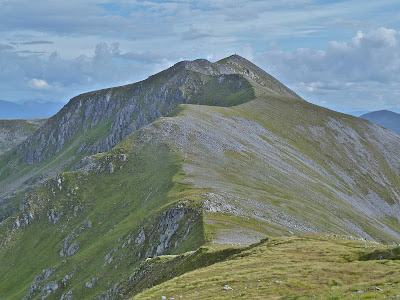 |
| Path from Aberarder |
 |
| Coire Ardair |
 |
| Not the summit |
 |
| Coire Ardair from Stob Poite Coire Ardair |
 |
Above the window and Creag Meaghaidh summit - far right |
 |
| Exercising my Access Rights above Loch Laggan |
 |
Loch Laggan and Gael Charn |
Thursday, 9 August 2012
Distance: 23 kilometres
Ascent: 1180 metres
Time: 5 hours 44 minutes
m Creag Meagaidh 1128m 2hrs 23mins
m Stob Poite Coire Ardair 1054m 3hrs 18mins
t Sron Coire a' Chrochairein 993m
m Carn Liath 1006m 4hrs 35mins
A text from Alex who was in Aviemore for the week, would I fancy climbing the Monaliadhs? No, I had made my five yearly pilgrimage to these hills a couple of weeks ago and they are not that alluring. We negotiated other possibilities and settled on Creag Meagaidh. The weather was promising and I could be home in time to watch David Rudiche (certainly the athlete of the games for me) in the 800metres. I left home at 7:45am but with the A9 in one of its elastic traffic days (you chug along in line for 4 or 5 miles and then shoot forward at the next section of dual carriageway) it was a slow trip and 10:15am before I arrived at Aberarder. The sun of the Trossachs had given way to cloud in Perthshire but as I headed west through Laggan the sun was promising to come through.
The Scottish Natural Heritage facilities at the start of the walk are first class including display boards, leaflets, toilet provision and a graded path for the first 6 kilometres into Coire Ardair. This is a National Nature Reserve where deer management has allowed the regeneration of native trees in the glen. We were mobbed by butterflies, caterpillars littered the paths but the cloud cover remained. It was easy walking along a superb footpath until Coire Ardair. Then 300 metres of climbing to the Window, the gap and entry to the Creag Meagaidh plateau above Coire Ardair. We climbed the steep grassy slope to the upper lip of the cliffs and peered down, the famed deep corrie with its lochan was lost in the mist.
It is an easy ramble across the grassy plateau to the summit. We lunched on the top of a large cairn that looked like the spoils of some mining activity. At the back of my mind, I had a premonition that this was not the summit but it looked like a giant Balti Pie so Alex was happy. Before we finished our food the cloud lifted to reveal an unassuming cairn on the top of a gentle rise about 500 metres away - the real summit of Creag Meagaidh and we sauntered across as I recalled that I had spent twenty minutes in poor visibility on a previous visit going round in circles with a compass in hand before finding the summit, I have not invested in GPS .
We wandered back across the plateau and then dropped back down to the Window meeting a pair of Irish walkers who were climbing 52 munros for charity during the month of August - they seemed very content. From the Window there is only one more real climb for the day and that is a quick 10 minute slog up to Stob Poite Coire Ardair. At last it was becoming brighter. The long easy ridge walk to Carn Liath is a pleasant stroll in the park with open views to the north over the Monalaidhs and south to Ben Alder.
The visibility was excellent and the sun arrived as we caught a couple of older walkers with dogs, whom we had met as we left in the morning. They had an easy cadence, wore wool, bonnets and had the demeanour and easy manner of previous generations of walker. They knew their hills and the wildlife and we spent 10 minutes with them on the top of Carn Liath admiring the panorama of Scotland from the Cairngorms and Glenshee, Glen Lyon, the Roy hills, Glen Affric, Ben Wyvis and as far as Morven in Caithness. They had binoculars and we charted the ground works and new track for the upgraded Beauly to Denny power line through the Corrieyairack pass.
We headed south down the grass and scree slopes to Aberarder. It was easy walking down to 600 metres and then a muddy path that skirts east of the outlier of Na Cnapanan before dropping through dense vegetation that needed some thinning out - where are the deer when you need them - to the well engineered path below. We were down well ahead of expectations - I had assumed 7 hours for the walk and I was home for 7pm in time to watch the women's football final but I forgot; I will need to get a report from my friend who had bought tickets for the game, it can't have been as bad as the men's final.

















































